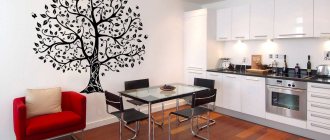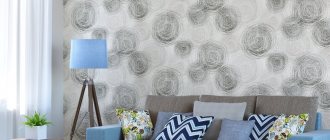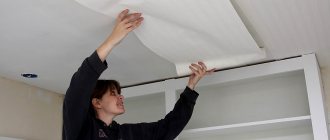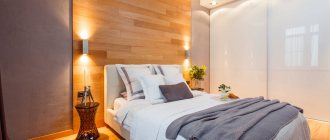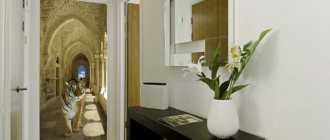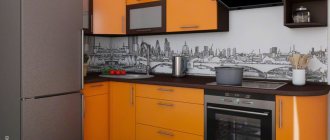You don't have to be a professional to figure out which wallpaper is washable and which isn't. It is enough to know the decoding of the pictograms that are indicated on each roll of wallpaper.
One wave - moisture resistant. This sounds promising, but what does this mean for wallpaper cleaning? It turns out that this is not the best option for the kitchen. Such wallpaper can only be wiped with a damp sponge, without detergents, pressure or friction.
Two waves - washable. The situation is a little better than with moisture resistant ones. Add soap or dish gel (weakly alkaline products) to a wet sponge. They remove fresh dirt and dust well, but they are unlikely to cope with grease.
Calculate the exact cost of repairs using an online calculator
and receive a free detailed estimate for repairs
Calculate
Three waves are super washable. A great option for kitchen wallpaper! Chemical agents come to the aid of a wet sponge to remove greasy stains and stagnant dirt. And such wallpapers are not afraid of water. Unless, of course, you pour it on them in buckets.
Wave and brush are the most super washable option. Wallpaper with this marking is not afraid of not only water, but also hard brushes. High moisture resistance and wear resistance increase the number of cleanings without losing the appearance of the wallpaper. There is one drawback: high cost.
Photo: hundred-worries.com
What is washable wallpaper?
Washable wallpaper is not a separate type of wallpaper, but the quality of the coating. The degree of moisture resistance may vary; markings are indicated on the back of the roll or packaging. Washable coatings are mainly used to decorate the kitchen, which greatly simplifies the life of the housewife.
How to determine that wallpaper can be washed?
To determine whether kitchen wallpaper can be washed, you need to pay attention to the markings that are indicated on the back of the roll or on the packaging. The designation determines the resistance of the purchased material to moisture.
Marking
Helps determine the degree of interaction of the material with water and the method of care.
| Icon | Name | Description |
| One wave | Waterproof | The material has little contact with water. The surface is wiped with a damp soft cloth. Not recommended for use in kitchen finishing. |
| Two waves | Washable | Moderate contact with water. Care is carried out using a regular rag or sponge and a slightly alkaline solution. Fresh dirt, dust and stains, with the exception of greasy ones, are removed from the surface. |
| Three waves | Super washable | The surface interacts well with water. When cleaning, you can use a rag, sponge and soap solution. A good option for finishing a kitchen. |
| Three waves and a brush | Friction resistant | Maximum moisture resistance. When cleaning, you can use a sponge, rag, brush and soapy water. An ideal option for finishing the kitchen. |
Marking of washable wallpaper
In order to correctly and quickly select wallpaper with the desired characteristics, you should read and understand the labeling on the packaging. The marking encodes the type of wallpaper material, what room it is for, the degree of its water resistance and much more. Marking on rolls is done in the form of graphic symbols, letters or numbers.
Decoding instructions for wallpaper care
Notes on lightfastness of wallpaper
Other icons explain how to apply glue, how to join patterns, and how to remove wallpaper.
The alphabetic and numerical parts of the marking provide information about the wallpaper material, the manufacturer, and the environmental safety of the wallpaper.
Letter part of the marking
What types are there?
Vinyl
The wallpaper is washable, which means it is suitable for decorating the kitchen. The coating is a two-layer fabric, made of a paper or fabric base and a polyvinyl chloride coating.
Vinyls can be divided into three subgroups, flat, dense and foam. Flat vinyl wallpaper is a washable material made by hot stamping, that is, the foam vinyl is smoothed. The material has a wide selection of colors and textures, including silk-screen printing, and can also imitate various surfaces.
Foamed vinyl wallpaper has a clear textured surface, which allows you to mask small unevenness in the walls. Not the best choice for the kitchen, although they can also be wiped with a damp cloth.
The photo shows a kitchen decorated with washable wallpaper companions.
Dense or hard vinyl wallpapers are thicker than others, the material is durable and moisture-resistant. The pattern on the canvases is made using hot stamping. A convenient option for use in the kitchen and hallway.
The photo shows a kitchen with a modern design, the walls are decorated with green vinyl wallpaper.
Photo wallpaper
Wallpaper with photo printing is first and foremost an effective way to decorate a kitchen, and only then a practical surface. Photo wallpapers themselves will not be the best option for finishing a kitchen, but a laminated surface radically changes things.
Washable wallpaper with a laminated surface can be wiped with damp cloths; in addition, it does not absorb dirt and greasy stains, which is very convenient for kitchen conditions.
The photo shows a loft-style kitchen. One of the walls is decorated with washable photo wallpaper.
Fabric based
To decorate the kitchen, you should choose washable wallpaper on a fabric basis. These could be the aforementioned vinyl coverings. The base provides additional strength; this type of finish will be more reliable than with a paper base.
The photo shows a spacious kitchen in a classic style, decorated with bright red washable wallpaper.
Non-woven
Washable coatings are divided into two types: paintable and ready-made coatings that do not require additional manipulation. The coating consists of a flat surface and a raised second layer, which forms a repeating ornament or a whole pattern.
If a paintable type is chosen for the kitchen, then to make it washable you need to choose water-based paint.
Liquid
In its original form, it is a dry mixture, which is diluted in a certain ratio with water and only then applied to the kitchen walls according to the principle of plaster. The coating helps hide uneven walls and does not require careful surface preparation. To allow wet cleaning, the surface must be coated with acrylic varnish.
Paper
Although wallpaper is attractive due to its price and variety of colors, it is considered the most impractical material, as it tends to absorb odors, fade in the sun, is easily damaged and is almost impossible to wash from various kinds of stains.
If you choose a washable paper covering for the kitchen, film wallpaper is used. Essentially this is wallpaper with a water-repellent coating; the surface has a glossy outer layer that allows for wet cleaning.
Glass wallpaper
Fiberglass washable wallpaper has a composition that is fundamentally different from other types. The coating is made from glass blanks, which are drawn into fibers under high temperature. They subsequently turn into the strongest fabric.
Fiberglass wallpapers are universal, they can be painted and washed many times, they are not subject to combustion, prevent the appearance of mold, and are also extremely resistant to damage. However, they have a fairly high price and do not have such a large selection of textures as other types.
Metallized
Washable wallpaper with a spectacular appearance. The coating consists of a paper base covered with aluminum foil and paint. The surface has a pattern that shimmers beautifully in the light. Wallpaper can be wet cleaned, but practically does not allow air to pass through.
For painting
Different types are suitable for painting, such as non-woven or fiberglass. It is important to choose the right paint for painting, most often it is water-based paint.
Natural wallpaper
Natural washable wallpaper boasts an environmentally friendly and harmless composition, which cannot be found in many finishing materials. Cork or bamboo wallpapers have a recognizable texture; although they are not distinguished by a rich variety of colors, they still make the kitchen interior unique and support an eco-theme.
Wallpaper is washable and can be wiped with a damp cloth.
Cork wallpaper with wax coating
This is the most natural wallpaper, because it is made from the bark of the cork tree. It is the wax impregnation contained in their composition that will allow you to wash such wallpaper.
Cork wallpaper has good heat and sound insulation, does not absorb odors, and is easy to care for. But such wallpapers cannot boast of a large number of colors.
They are also very easy to damage, so when cleaning it is better to use water and a soft cloth.
Advantages and disadvantages
A detailed consideration of the pros and cons allows you to choose the ideal washable coating option for yourself.
| Coverage type | Advantages | Flaws |
| Vinyl | Durable coating, can be applied to different types of surfaces, hides minor defects in walls, large selection of colors, possibility of wet cleaning. | The coating reacts to sudden changes in air humidity and temperature. Flat vinyl has a non-breathable surface. |
| Photo wallpaper | The ability to perform wet cleaning on laminated photo wallpapers, a wide selection of images. | The surface does not breathe. |
| Fabric based | Breathable, vapor permeable and durable material. | The vinyl top layer will not allow air to pass through. |
| Non-woven | A wide variety of choices, wide canvases, durable material, hide wall defects. | The relief of the design can easily be damaged by the accumulation of dust in the relief. |
| Liquid | Easy to clean, breathable surface, no seams. | High cost, limited color palette. |
| Paper | Wide choice of colors, low cost. Film wallpaper can be washed. | Do not breathe, low strength of the material, applied only to a flat wall. |
| Glass wallpaper | Durable fabric, washable and repaintable. Fire resistant, mold resistant, durable, environmentally friendly and safe. | High cost, small selection of textures, difficult to remove from wall surfaces. |
| Metallized | Spectacular appearance, possibility of wet cleaning, resistant to fungus and mold, long service life. | The surface of the wallpaper does not breathe, it is applied only to smooth walls, high cost. |
| For painting | Depending on the type of wallpaper, the possibility of repeated painting, a breathable surface, the ability to choose any color. | Some types of wallpaper that can be painted can be expensive. |
| Natural | Eco-friendly, safe, wet cleaning possible, do not fade in the sun, long service life. | Limited selection of colors and patterns. |
Design options
Under decorative stone
Imitation of decorative stone can decorate a kitchen in modern, loft, country, and Provence styles. The stone will look harmonious with other types of washable coatings; the surface can be plain or with a small pattern.
The photo shows a country style kitchen. The wall decoration imitates large stonework.
Under the brick
It looks equally good in a brutal loft interior and a delicate Provence style. A wide range allows you to choose any color, shape and size of the pattern, and also significantly saves time on finishing and space in the kitchen.
Under tiles
Washable tile wallpaper will be an interesting option for decorating a kitchen. They can completely decorate the entire kitchen, including the apron area, or decorate only the dining area. This type of pattern looks good as companion wallpaper, echoing other colors and patterns, such as small mosaics and Gzhel patterns.
Under the tree
Popular eco-themes have not retreated for several years. Real wood is not the best option in the kitchen; wallpaper with its imitation will be an excellent alternative. It will take a lot of effort to create a certain tone and apply a pattern to a wooden panel; with wallpaper this problem will not arise.
In a cage
The checkered pattern can be small, large, plain, or Scottish. There are quite a few variations. If the walls are decorated with a checkered pattern, then the set should be chosen in a single color, in the color of the background or wallpaper pattern.
With flowers
The floral pattern will always be relevant. The size of flowers can be completely different, from an inconspicuous small one to a large flower depicted using photo printing.
The photo shows a bright kitchen in Provence style. The decoration is made with washable wallpaper with a pattern.
Flowers can also reflect the different style and mood of the kitchen, for example, a large orchid of a delicate shade on the wall behind the dining area will make the interior elegant and delicate, and large bright pink peonies will give the interior a romantic mood.
The photo shows a stylish kitchen, the wall is decorated with lilac photo wallpaper with flowers.
Under bamboo
Washable wallpaper with imitation bamboo will support the natural theme in the kitchen interior. Unlike real bamboo flooring, wallpaper is not as limited in color choices. The design can also repeat a bamboo stem with foliage; this option is suitable for a Japanese theme.
Kitchen - delicious wallpaper recipe
Modern kitchens have long lost their reputation as a purely functional area, so they are often decorated with wallpaper that can emphasize the individual taste of its owners. But here, too, you need to take into account several basic characteristics and design rules.
Color selection
Colors are tools for creating a certain mood and atmosphere in a room. Typically, kitchens require lighter and more stimulating colors. Darker shades should only be used sparingly. However, decorating a wall with black as the main color can provide a great visual contrast to white walls. The effect will be modern and stylish.
Colors are tools for creating a certain mood
Kitchen wall colors can have a subconscious effect on our energy, creativity, and appetite. Yellow, red, orange will be the most successful kitchen colors. The more intense and brighter the shade, the stronger its effect. Purple is a creative, “magical” color—great for budding cooks and food adventurers.
Kitchen wallpaper with cool, light shades of blue, gray or metallic silver creates a sophisticated living room effect, especially when combined with modern kitchen furniture and equipment. Green kitchen wall decor adds freshness to the room.
Green is known to have a balancing, calming effect that relieves stress. Various light or dark shades of brown remind us of coffee, chocolate or nuts - which are used in the kitchen and stimulate our senses. Brown kitchen walls also suit a range of classic and contemporary interior styles.
Stripes are always in trend
When combining colors, you must first of all take into account harmony and balance. As a neutral tone, white is a great partner for other colors. The motif depicting fruits and herbs refers to the theme of cooking. Collections of kitchen utensils such as spoons or plates are often used in kitchen decor.
Just make sure the patterns and colors enhance the layout and ambiance of the room. They have a significant impact on the visual impression of the height, size, brightness, and mood of the room.
What else should you pay attention to?
Small kitchens benefit most from:
- light wallpaper with small or delicate patterns/motifs;
- with glitter or metallic effects;
- 3D patterns that increase space;
- with thin horizontal stripes, small classic patterns, small polka dots.
Green in the bathroom interior
Larger or brighter patterns should be limited to only one wall or part of a wall.
For low ceilings, structural patterns such as horizontal stripes or diagonal patterns are preferred. Apply wallpaper up to the ceiling to achieve the effect that the pattern continues endlessly . Subtle or thin lines are suitable for small rooms with low ceilings.
For high ceilings, use plain wallpaper at the bottom of the wall, then patterned wallpaper near the ceiling.
Walls with tile patterns for the kitchen
Modern kitchens often only have tiles on the floor, as even the backsplash on the wall is often replaced with modern, easy-to-clean materials that have the added benefit of being easy to install. Nevertheless, walls imitating tiles remain a popular choice for the kitchen, as confirmed by striking examples from designers. This latest trend is reflected in the Spanish style Majolica tile models, inspired by the world famous master architect Antoni Gaudí.
French style bathroom
Practical characteristics and surface materials
Since kitchens or cooking areas are constantly exposed to steam and condensation, kitchen walls must meet certain requirements such as resistance to humidity and durability.
Of course, they must be washed well, since food will inevitably get on them during cooking . In addition, you need to consider whether the kitchen wallpaper will be located near a fire source, for example, near a stove or table. There are many spills and stains in the kitchen, many of which can be quite challenging.
Wallpaper under tiles
Depending on the type of potential stains and cleaning requirements, washable kitchen wallpapers are divided into the following categories:
- water resistance;
- high water resistance;
- scratch resistance;
- high scratch resistance.
For kitchen walls that need to be washed, both types of vinyl are most suitable. Some surface materials are not recommended for use in the kitchen because they are susceptible to moisture/steam - in addition to natural and textile materials, this list also includes fiberglass . In terms of sophistication and ease of care, leather-look vinyl is a stunning solution for kitchens.
Exquisite bathroom
Since every kitchen contains a stove and oven, it is the highest risk room in the home . As a result, fire-resistant wallpaper should be preferred in the kitchen, and the choice of fiberglass is justified here, the main thing is that it is not located near condensation.
Kitchen wallpaper should also provide qualities such as durability and a stronger grain so that minor damage does not have a big impact on the overall appearance.
Color spectrum
White
White color has many advantages. It goes well with any shades, suits any design style, and most importantly visually makes the kitchen space larger. White can be taken as the main color or used as an additional color, combined with bright colors.
Greens
Green color has many shades, from bright young greenery to dark olive, which, by the way, is more suitable for decorating a spacious and well-lit kitchen.
The chosen shade should reflect the style of the kitchen, for example, rich colors are suitable for a modern style, a calm and muted green tone corresponds to a classic one.
The photo shows a bright kitchen in a modern style. The finishing is done in a light green shade.
Beige
A classic and universal shade will be a win-win option for decorating a kitchen. The beige tone can be combined with many shades; you can add bright colors to the interior in the form of a pattern on the wallpaper or through the color of the headset.
Black
A bold black tone should be used with caution in kitchen decoration. It is suitable for bright open spaces. Black can also be used as a secondary color, for example, in a pattern on washable wallpaper.
Two types of vinyl wallpaper
Wallpaper made of polyvinyl chloride (the same slang “vinyl”) can be solid or with a vinyl coating. The latter are often called acrylic. The former are made entirely from PVC, with a coating made from recycled paper or a combination of cellulose and textile fibers. And PVC is applied only as an additional protective coating.
Visually and structurally, both options provide almost unlimited design options. Deciding which one to choose is entirely a matter of practical preference.
Drawing in the form of kitchen utensils
With the paper version, glue is applied to each roll and then left to soak in. With non-woven wallpaper, the adhesive is applied directly to the wall, no soaking time is required. The roll can be applied to the wall once it has been cut to the desired length. In addition, PVC can be removed very easily, since they are completely removed from the wall, leaving no traces, without the need for pre-impregnation.
Paper ones are available with the following characteristics:
- “Remove after soaking.”
- "Remove dry."
Non-woven ones have additional functional features: they retain their shape, regulate humidity, and correct minor unevenness. PVC coated paper is less moisture resistant, but the sealed vinyl surface will not let any moisture through anyway.
Does not allow any moisture to pass through
Regardless of the base material, vinyl flooring is inherently moisture-repellent. The synthetic surface for decoration comes in many options, such as smooth, textured or embossed.
Example of use instead of an apron
Washing wallpaper can also be used to finish the apron area. To do this, you should choose a durable material that interacts well with moisture. Fiberglass, vinyl and paintable wallpaper would be a good option. It is better to cover coatings with poorer interaction with water with protective glass.
The photo shows an open kitchen in a modern style. The apron area is protected by transparent glass.
Tips for choosing
When looking for finishing materials, you should take into account all the nuances of the room, how sunny the kitchen is, the budget you have, and also take into account the characteristics of the washable coating
- The best type of washable wallpaper for the kitchen can be considered vinyl wallpaper with a non-woven backing. They have a breathable surface and a long service life.
- The best type of washable wallpaper for painting can be considered glassy wallpaper. The material is very durable and can withstand repeated staining.
- It is better not to choose paper wallpaper for the kitchen, even if it has a washable, moisture-repellent coating. They have a short service life and fade in the sun.
- To decorate the kitchen, it is better to choose a non-woven coating; it is durable and elastic, and also tolerates contact with water well.
Examples in the interior
To decide on the material, style and color of washable wallpaper, you should familiarize yourself with photographs of various kitchen interiors.
How to glue?
What glue is best for gluing?
Considering that most washable wallpaper is heavy, it is worth choosing the appropriate adhesive. There is a special glue for heavy types of wallpaper. When choosing a washable vinyl covering, you should choose an antiseptic adhesive with fungicides. Regardless of what type of washable wallpaper you choose, the adhesive composition must be moisture resistant.
Step-by-step gluing instructions
Finishing work with washable wallpaper is not much different from ordinary wallpaper. There is a certain procedure that will help you perform gluing consistently and efficiently.
- Preparing the walls. To do this, you need to remove the old finish, remove uneven areas and plaster the walls.
- Treatment with antifungal liquid.
- Primer of walls.
- Marking. Using a plumb line or level, a vertical line is drawn on the wall. It will become a guide for gluing and will help to avoid “collapsing” of the strip.
- Preparation of material. Cut the wallpaper into strips of the required length with a margin of 5-10 cm.
- Depending on the type of material, glue is applied, after which the strip is applied to the wall.
- The trapped air is smoothed out from the center to the edge using a roller.
Excess glue is removed immediately. Upon completion of the work, the wallpaper is cut to the same length.
Video
Proper care and washing
Even washable wallpaper coverings have care rules, following which you can extend the life of the wallpaper and maintain its original appearance.
- When cleaning, use a soft cloth or sponge, avoiding hard brushes.
- It is better to use a soap solution as a cleaning liquid, if the label allows it.
- Before carrying out wet cleaning for the first time, it is worth doing this in an inconspicuous area to check the reaction of the coating.
- Wet cleaning should be done as needed. Even washable coatings do not like too frequent contact with water.
conclusions
So, now you know how to choose washable wallpaper. It is worth paying attention first of all to the type and material you choose.
Also, decide in advance in which room you will use this type of wallpaper. This will significantly influence your choice.
Do not forget about the color combination, because the entire design should be harmonious and pleasant to perceive.

